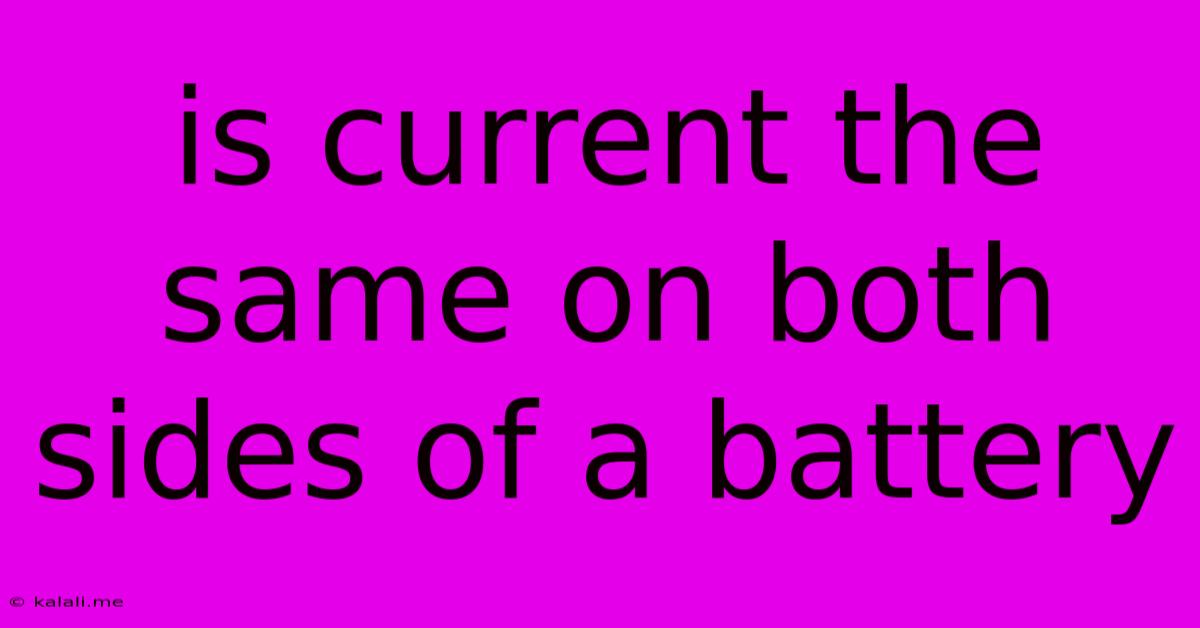Is Current The Same On Both Sides Of A Battery
Kalali
May 24, 2025 · 3 min read

Table of Contents
Is Current the Same on Both Sides of a Battery? Understanding Electrical Circuits
This article will explore the fundamental concept of current flow in a simple electrical circuit, specifically addressing the question: is the current the same on both sides of a battery? The short answer is yes, but understanding why requires a grasp of basic circuit principles. This explanation will delve into the intricacies of current, voltage, and resistance, providing a clear and concise answer suitable for both beginners and those seeking a refresher.
Understanding the flow of electrons within a circuit is crucial to understanding electricity. Electrons move from the negative terminal to the positive terminal of a battery, creating an electric current. This movement, however, isn't a simple linear progression. The current, measured in Amperes (A), represents the rate of this electron flow.
Current: The Flow of Charge
Think of a river. The voltage is like the water pressure, pushing the water (electrons) along. The current is the amount of water flowing past a specific point per unit of time. In an electrical circuit, the current is the flow of electrical charge, specifically electrons. A higher current means more electrons are flowing per second.
Ohm's Law: The Relationship Between Voltage, Current, and Resistance
Ohm's Law is crucial for understanding current behavior in a circuit. It states that current (I) is directly proportional to voltage (V) and inversely proportional to resistance (R): I = V/R. This means that a higher voltage will result in a higher current, while a higher resistance will result in a lower current.
Current in a Simple Circuit
In a simple circuit with a battery and a single resistor, the current is the same everywhere in the circuit. This is a consequence of the conservation of charge. Electrons don't magically appear or disappear; the same number of electrons flowing into a component must flow out of it. Therefore, the current entering the resistor from the battery's negative terminal is identical to the current leaving the resistor and returning to the battery's positive terminal. This is true regardless of the resistor's value; the resistance only affects the magnitude of the current, not its consistency throughout the circuit.
Series vs. Parallel Circuits
The consistency of current throughout a simple circuit changes when we consider more complex circuit configurations, specifically series and parallel circuits.
-
Series Circuits: In a series circuit, components are connected end-to-end. The current remains the same throughout the entire circuit. Each component experiences the same current flow.
-
Parallel Circuits: In a parallel circuit, components are connected across each other. The current splits among the branches. The current through each branch may differ, but the sum of the currents in each branch equals the total current entering and leaving the parallel section. However, the current entering and leaving the entire parallel circuit section remains the same.
The Battery's Role
The battery acts as a pump, maintaining the potential difference (voltage) across the circuit. It doesn't "use up" the current; it provides the energy that drives the electron flow. This flow maintains its consistency across the circuit, barring any branches or splits as seen in parallel circuits. The current leaving the positive terminal is identical to the current entering the negative terminal.
In conclusion, while the voltage changes across components in a circuit, the current remains consistent throughout a simple series circuit. This principle is fundamental to understanding and designing electrical circuits of any complexity. The same number of electrons flow into and out of any point in the circuit, adhering to the principle of charge conservation. Therefore, the answer to the initial question remains a resounding yes.
Latest Posts
Latest Posts
-
Map Of Middle Earth Frodos Journey
May 24, 2025
-
Bright Colors Losing Detail Gimp Coloraize
May 24, 2025
-
Is Momentum Conserved In An Inelastic Collision
May 24, 2025
-
How To Change Recessed Light Bulb
May 24, 2025
-
Alts Platforms Other Than Linux And Windows Are Not Supported
May 24, 2025
Related Post
Thank you for visiting our website which covers about Is Current The Same On Both Sides Of A Battery . We hope the information provided has been useful to you. Feel free to contact us if you have any questions or need further assistance. See you next time and don't miss to bookmark.